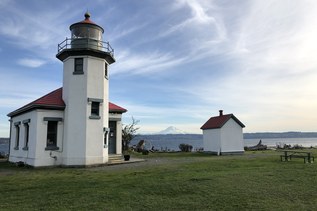Start your hike at the closure of the road by the marina. Walk along this flat paved portion and enjoy views out toward the Deception Pass bridge to the west and the Cascades to the east. There are several benches along this section for sitting and watching seagulls and boaters. In a few spots you can climb down and access the beach.
Stay on the road for .7 miles, come to an intersection with the East Hoypus trail and an old ferry landing. Detour left to go to the landing. Not much remains here but a bit of cement and a great place to do some beachcombing.
Head back to the intersection and follow East Hoypus trail around the tip of Hoypus point and along the eastern parameter. Start climbing gradually uphill among the trees and away from the water. Here is where you will find the big ones! The ancient cedars and big Douglas firs somehow managed to escape being logged until the area was annexed to the park, now they are safe. Notice too, the large logs, some new and some already covered with moss, ferns and new tree starts.
Identify these two common northwest trees as you hike. Western Red cedar the Native people called "tree of life" for its many uses. Look for gray or brown bark, that loosens in vertical strips, and flat needles. The tree has a slight fragrance. The Douglas fir, or Big Doug, as some like to call it, has rough brown corky bark. See if you can find a cone. The scales are loose, and the bracts that stick out the bottom look like a tiny mouse is inside with only its tail and hind legs showing.
You will come to an intersection with the Fireside trail. For a shorter loop back, you could take this one, but for this longer loop stay on the East Hoypus trail for another .3 miles until you reach the Hemlock Hideaway. Turn right onto this trail. The Hemlock trail takes you uphill to the top of the forested ridge. Ignore the side trails of Slug Slough and Forest Grove. Along this section you will find some logs beside the trail for lunch or a snack.
When you get to an intersection with Fern Gully, head down Fern Gully, which yes, has lots of sword ferns and yes, is a gully. You have left the big trees behind and are now in second growth forest, dark and quiet. A tough plant found all over the northwest, sword ferns, form large clumps, are evergreen and prefer a moist shady spot, but they can tolerate our dry summers. There is an intersection with the Julie trail, don’t take this one. The one you want for your return loop is the Little Alder Trail.
Turn right on the Little Alder Trail, misnamed. The alders here are mature and quite tall. In winter, the grey bark stands out among the green of the ferns. Alders thrive in areas disturbed by logging, growing in depleted soil. If you see a downed alder, look for little orange nodules on the roots, these are full of nitrogen fixing bacteria, providing nutrition for the tree and surrounding plants. A mature alder forest will be rich with an understory of ferns and grasses, you can see it on this section of the trail.
The Little Alder Trail intersects the Fireside Trail. Take the Fireside Trail for a short .3 miles, then turn on the West Hoypus Point trail and stay on this, ignoring the CCC crossing trails and reach the Coronet Bay closed road for a quick quarter mile back to your car.
Note: The trails are well signed, but the names are not on the state park map as of this writing.
WTA Pro Tip: There are lots more trails in this section of the park, it is possible to string together several for a longer day in the woods.







 Trailhead
Trailhead



